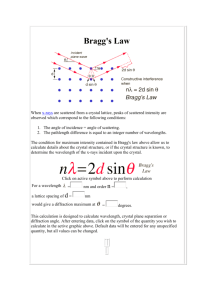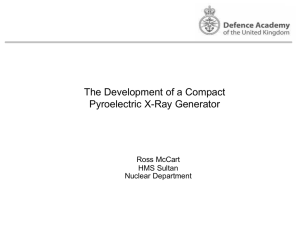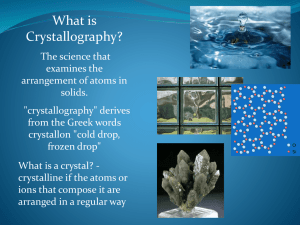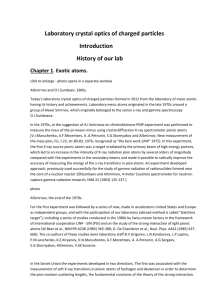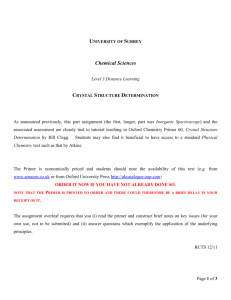Bragg Scattering
advertisement
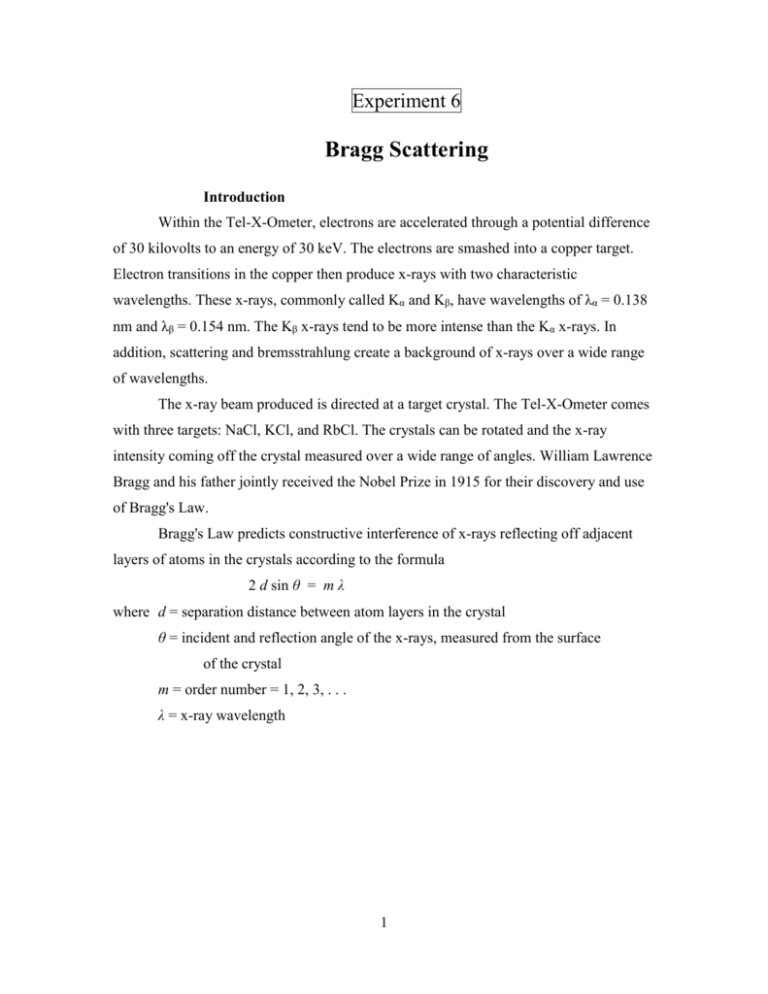
Experiment 6 Bragg Scattering Introduction Within the Tel-X-Ometer, electrons are accelerated through a potential difference of 30 kilovolts to an energy of 30 keV. The electrons are smashed into a copper target. Electron transitions in the copper then produce x-rays with two characteristic wavelengths. These x-rays, commonly called Kα and Kβ, have wavelengths of λα = 0.138 nm and λβ = 0.154 nm. The Kβ x-rays tend to be more intense than the Kα x-rays. In addition, scattering and bremsstrahlung create a background of x-rays over a wide range of wavelengths. The x-ray beam produced is directed at a target crystal. The Tel-X-Ometer comes with three targets: NaCl, KCl, and RbCl. The crystals can be rotated and the x-ray intensity coming off the crystal measured over a wide range of angles. William Lawrence Bragg and his father jointly received the Nobel Prize in 1915 for their discovery and use of Bragg's Law. Bragg's Law predicts constructive interference of x-rays reflecting off adjacent layers of atoms in the crystals according to the formula 2 d sin θ = m λ where d = separation distance between atom layers in the crystal θ = incident and reflection angle of the x-rays, measured from the surface of the crystal m = order number = 1, 2, 3, . . . λ = x-ray wavelength 1 Experiment Record the observed counting rates, using the NaCl crystal as the target, as a function of 2θ in the datasheet template. Notice that in the regions of 25-35o, 55-70o, and 90-115o we go in steps of 1o. Once the individual peaks in the counting rate are identified, data will be taken in smaller steps, as small as 10 min or 15 min of arc. Record the data in the space provided. Also make sure that you record the counting rate normalized to the same counting period, e.g. counts/sec. NOTE: If you are unable to take and record data, a fully filled out data sheet with data taken between 2θ = 11° to 2θ = 124° will be provided to you. If there is sufficient time available in the lab period, you may later replace the NaCl target with KCl and RbCl crystals and repeat the measurements for the m=1 peak and the more intense Kβ x-ray. Space is provided on the datasheet for these measurements. Study the data sheet and determine the angles – as accurately as you can – at which maxima (constructive interference) occurred. You should find at least five clear angles at which maximum intensities occur, the first two are around 2θ = 29° and 2θ = 31°. Assuming the first two maxima you found correspond to m = 1 and the two wavelengths λα and λβ given above, calculate d, the distance between the crystal layers in NaCl. The crystal rotates only 1/2 as much as the control arm so you must divide the listed 2θ angles by 2 to get the actual reflection angle θ. The other angles at which you found maxima should correspond to higher-order maxima. Calculate the wavelengths for these assuming m = 2 or m = 3. You should get very nearly the same value for d as for m = 1; if not, try using a different m value or recheck your work. 2 (Q1) How does your measured value of d compare with the accepted experimental value? You may find such a value by searching for the lattice constant of various crystals. Note, however, that the lattice constant is typically defined as 2*d. (Q2) Which x-ray wavelength was more intense (based on the number of counts per second)? (Q3) Which wavelength and order seems to be missing in this data? (Q4) For the missing maximum of question 2, at which angle should the maximum have occurred? (Q5) Examine the data, can you find evidence of the "missing maximum" of question 3 in the data? (Q6) Which measurement of d would you think is most accurate? The measurements for m=1, or 2, or 3? The measurements for λα or λβ? Explain why. Other Crystals Using the more intense x-ray wavelength (see question 1), the m = 1 maximum was measured for KCl and RbCl, the experimental results were 2θ = 28.4° for KCl 2θ = 27.16° for RbCl or substitute your measured values. Calculate the atomic spacing d for each of these crystals. Also look up the atomic numbers of Cl, Na, K, and Rb using the periodic table. (Q7) Describe any pattern you discover regarding the crystal spacing and atomic numbers for the three crystals. These crystals all have a similar structure, like cubes with alternating atoms at each corner. Like that shown in the figure to the right. The Handbook of Physics (Springer 2002) gives values for the radii (distances to the outermost electrons) of these atoms and their most common ions: 3 d Cl 0.089 nm Cl– 0.181 nm Na 0.189 nm Na+ 0.097 nm K 0.236 nm K+ 0.133 nm Rb 0.248 nm Rb+ 0.147 nm (Q8) Can you explain, in terms of atomic shells and electrical forces, why the atoms and ions have different sizes? (Q9) If atoms behave like hard spheres with the radii listed above and if they are packed together to the point of "touching" in the crystals, then what would you expect for the layer spacing (d) of each crystal? Calculate for both the neutral atoms and ions. (Q10) Which values, the d values for the neutral atoms or for the ions, better matches the experimental results? 4 2q 15.00 20.00 25.00 26.00 27.00 28.00 29.00 30.00 31.00 32.00 33.00 34.00 35.00 40.00 45.00 50.00 55.00 56.00 57.00 58.00 59.00 60.00 61.00 62.00 63.00 64.00 65.00 66.00 67.00 68.00 69.00 70.00 75.00 80.00 85.00 90.00 Counts/s 2q 91.00 92.00 93.00 94.00 95.00 96.00 97.00 98.00 99.00 100.00 101.00 102.00 103.00 104.00 105.00 106.00 107.00 108.00 109.00 110.00 111.00 112.00 113.00 114.00 115.00 Counts/s 2q Peak 3 Peak 4 Peak 1 Peak 5 Peak 2 Peak 6 5 Counts/s Bragg Diffraction Data for: 25.00 26.00 27.00 28.00 29.00 30.00 31.00 32.00 33.00 34.00 35.00 Bragg Diffraction Data for: 25.00 26.00 27.00 28.00 29.00 30.00 31.00 32.00 33.00 34.00 35.00 Counts/s Peak 2 Peak 2 6 Counts/s
